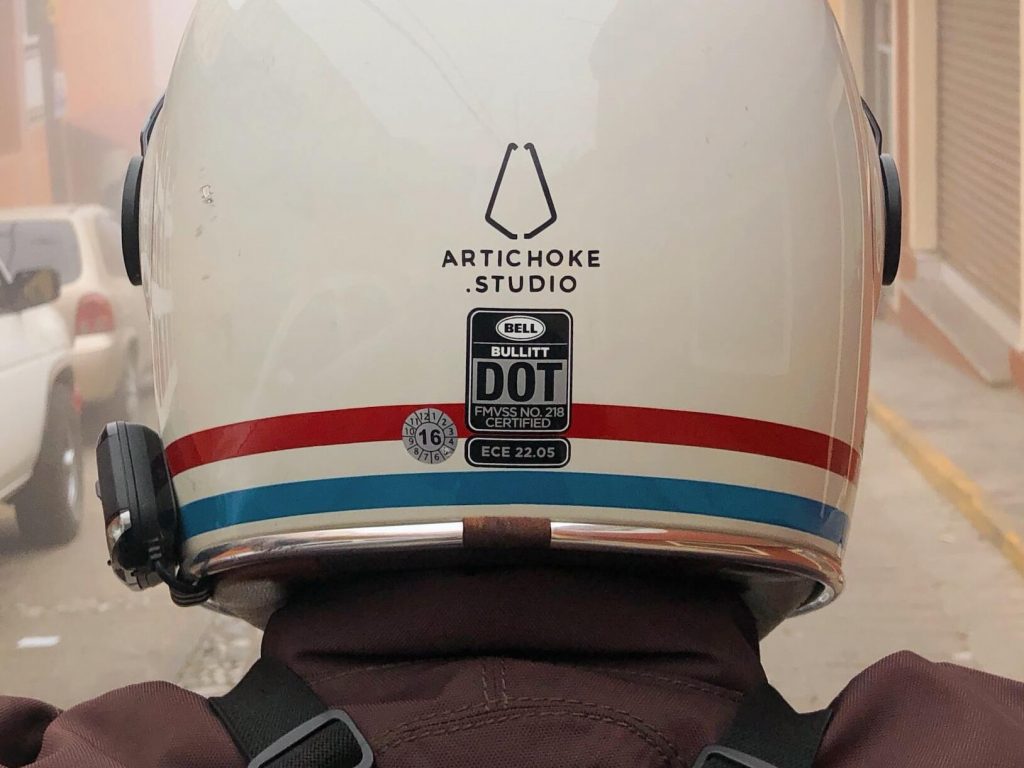Whether you live in a place where you can ride ATVs on public roads or if you consider using your ATV helmet when riding a motorcycle, you need to make sure the helmet you use is street-legal.
In the U.S., any helmet designed for on-road use must comply with a set of performance requirements in a safety standard issued by the Department of Transportation (DOT).
Most ATV helmets meet the U.S. Department of Transportation’s (DOT) minimum safety standards for motorcycle helmets. To show they comply, these helmets should have a DOT label, which is the manufacturer’s way of certifying that the helmet adheres to the safety standard.
Note that a DOT sticker alone does not guarantee the helmet is safe or legal. There have been numerous reports of manufacturers putting fake stickers on their helmets. Luckily, there are ways to distinguish a good helmet from a bad one.
DOT Do Not Approve or Certify Helmets
The term “DOT-approved” can be a bit confusing. Here’s what it means:
All helmets designed for motorcyclists and other motor vehicle users must comply with FMVSS (Federal Motor Vehicle Safety Standards), Standard No. 218; Motorcycle helmets.
The standard is issued by NHTSA (National Highway Traffic Safety Administration), specifically DOT (Department Of Transportation).
DOT is a government enforcement authority governing national highway traffic safety in the U.S.
It’s a common misconception that helmets must be tested or certified by the DOT to be “DOT-approved.” But that is not how it works.
NHTSA/DOT is not a certification body and does not test and approve helmets.
The standard is based on self-certification. It requires that the manufacturer does all the testing necessary to issue a certification that the helmet conforms to the standard.
NHTSA/DOT enforces the standard by choosing random helmet test samples sent to an independent third-party test lab to see if the samples comply with the standard.
Manufacturers that market and sell non-compliant helmets are subject to heavy fines.
In short, DOT makes the rules, but the manufacturers are the ones that must make sure the helmets they produce and market for on-road use comply with the laws.
What Are the Dot Helmet Requirements?
The standard (Standard No. 218; Motorcycle helmets) contains minimum helmet performance requirements and applies to all helmets marketed and sold for on-road use in the U.S.
For specific details on the requirements, always refer to the applicable standard. Here is the outline of the requirements of the standard.
Impact resistance. The standard specifies a list of acceleration attributes that shall not be exceeded when conducting an impact attenuation test according to instructions provided in the standard.
Penetration resistance. The standard describes a penetration test in which the striker shall not come in contact with a specified test head form.
Retention system. The helmet’s retention system and all of its components should attain a specified load without separating. The adjustment part of the retention system shall only move up to one inch measured before and after a specified load was applied.
Protective surface. The helmet must have a continuous protective cover above a specified line.
Peripheral vision clearance. The standard contains detailed requirements for how large a field of view the helmet must provide.
When Are You Required to Wear a DOT-Approved Helmet?
ATV helmet laws vary throughout the U.S. and Canada.
The U.S. ATV Helmet Laws
In the U.S., national safety laws ensure all helmets marketed for on-road use are safe and provide a minimum level of protection to reduce injuries and deaths from head impacts.
However, whether you are required to wear a helmet varies from state to state and is not determined by the DOT.
When state laws require that you use a helmet for on-road riding, the helmet must be DOT-compliant.
Some states have laws that require that you use a DOT-approved helmet outside public roads as well. One example is the Wisconsin ATV Safety gear requirements:
“All ATV/UTV operators and passengers under the age of 18 are required to wear a minimum DOT standard ATV or motorcycle helmet with the chin strap properly fastened. Bicycle helmets do not meet this requirement.”
The universal helmet requirement is supplemented with a list of exceptions of situations where a helmet is not required.
Canadian Helmet Laws
The ATV helmet laws vary throughout the provinces and territories.
In some places, you get to choose from several safety standards. In other areas, you are bound to just one standard.
For instance, in British Columbia, helmets for on-road use must meet one of the following helmet testing and certification standards: DOT, SNELL, or ECE.
In other places like Ontario, you can choose between CSA (Canadian Standards Association) and BSI (British Standard Institute) standards.
These are only examples and may be subject to change. Always refer to your local authorities for the current helmet requirements.
It is generally recommended that you always wear a DOT-compliant helmet whenever you ride your ATV, regardless of state laws, both on and off-road.
How to Know if a Helmet Is Dot Approved

As I mentioned initially, you shouldn’t trust the DOT sticker unquestioningly. Some dishonest sellers buy fake DOT stickers and place them on non-certified helmets.
A non-compliant helmet is typically lighter and thinner than a DOT-compliant motorcycle/ATV helmet and looks more like a bicycle or extreme sports helmet.
Look for a Proper Dot Certification Label
DOT labeling requirements have become more specific throughout the years to reduce the risk of counterfeit labeling.
Here’s the correct format for the label on a DOT-compliant helmet:
- The “DOT” symbol should be in the center of the label, placed horizontally.
- The helmet’s model name or number should be above the “DOT” symbol, also centered and horizontal.
- “FMVSS No. 218” should be below the “DOT” symbol, also centered and horizontal.
- The word “CERTIFIED” should be placed beneath “FMVSS No. 218”, centered and horizontally.
The standard also includes formatting requirements that can help identify a counterfeit label.
Consider the Helmet’s Weight and Thickness
A DOT-certified helmet typically weighs around three lbs to withstand the performance requirements. Its inner liner is typically made up of foam with a thickness of at least one inch.
If the helmet weighs around one lb and is significantly thinner than one inch, it likely won’t comply with the DOT-standard requirements.
Look for Open Ventilation Ports
A DOT-compliant helmet should have a continuous contour. Large ventilation ports like you typically find on bicycle helmets tell you that the helmet is not DOT-approved.
Look for a Secure Chin Strap
Consider the sturdiness and design of the chin strap and its locking mechanism. Bicycle-style chin straps typically won’t withstand the DOT retention system requirements.
Look for a Manufacturer’s Label
The DOT helmet standard requires more than the certification label. The helmet should also have a label indicating the manufacturer’s name, discrete size, month and year of manufacture, and materials the helmet is made of.
There should also be a warning label against subjecting the helmet to certain substances, recommended cleaning agents, and a warning against modifications.
If any of these labels are missing, it may cause suspicion.
Look For Other Helmet Test Standard Labels
Outside government minimum helmet standards like DOT (U.S.) and ECE (Europe), there is a range of private standards and testing organizations such as SNELL and ANSI.
These voluntary non-profits typically aim to raise the performance requirements from the minimum government ones to get even safer helmets.
The testing standards for helmets can overlap. This means it’s pretty common for a helmet to be certified under multiple safety standards simultaneously.
If you, for instance, see a snell badge in addition to the appropriate dot sticker, this dramatically increases the chances of an authentic DOT certification.
We won’t get into the difference between the standards in this post as there is plenty of information on this subject on other sites.
Not All Dot-Approved Helmets Are Suitable for ATV Riding
There is no universal definition of what an ATV helmet should look like. A wide range of helmet types fit within the boundaries of the DOT minimum requirements, but not all of them offer ideal protection for ATV riding.
ATV riding involves a lot of debris and flying rocks, so it’s essential to use a helmet with a closed-face design that offers complete face and eye protection.
Open-face designs are not recommended despite some of them being DOT-certified, as they offer little, if any, protection to the face and eyes.
Motocross-Style Helmets

What most people think of when referring to an ATV helmet is a motocross-style helmet. These are also called MX helmets, offroad helmets, dirtbike helmets, and more.
These are lightweight, well-ventilated helmets with a visor and a robust chin guard. They are designed to be used with goggles for eye protection. These are ideal for most forms of ATV riding.
ATV and motocross helmets are essentially the same but may have different graphics.
Related: Why Do ATV and Motocross Helmets Have Visors (Peak)?
Motorcycle-Style Helmets

Some people use motorcycle-style helmets with a full face shield. While safe, there are better alternatives for active ATV riding, but it does a decent job on the trails.
Related: The difference between an ATV helmet and a motorcycle helmet
Steer clear of the models with a flip-up chin guard. Active ATV riding generates a lot of heat and may fog up the visor, leaving you tempted to flip up the guard in a difficult situation when you may need protection the most.
Dual Sport Helmets

Dual sport helmets are a combination of motorcycle-style helmets and motocross helmets. They are typically lighter than other full-face helmets and offer better visibility.
However, they use a visor rather than googles, which may lead to fogging in technically challenging slow-speed ATV riding applications.
Bell Helmets (Beanie Style)

Many bell helmets comply with the DOT requirements, but the open-face design offers no chin guard or eye protection.
ATV rentals typically offer this helmet style to their customers, although there are safer alternatives. They probably do so for hygienic purposes and convenience, and they likely also do so from a cost perspective.
I can’t imagine a situation where I would recommend an open-face helmet style over a full-face helmet for ATV riding. Nevertheless, some are still legal according to the DOT minimum requirements.
Related: Do ATV and Motocross Helmets Expire? How Long Do They Last?
